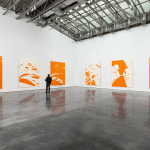“Camille Pissarro: Impressions of City and Country,” Jewish Museum, New York, NY. Through Feb. 3, 2008.
Nearly 50 paintings and works on paper culled from New York area public and private collections are presented in “Camille Pissarro: Impressions of City and Country.” Karen Rosenberg reports in the NYTimes that Pissarro was the true revolutionary among the Impressionists. ” Pissarro, an anarchist and a Jew (albeit a secular one) in 19th-century France, Impressionism was about much more than the fleeting effects of light. It was about labor, the elimination of hierarchies and an idealized balance between urban and rural life….In this show the political symbolism sometimes feels forced (as when the curators single out the motif of winding paths); in the paintings themselves it never does. Rather than silhouetting his peasants against the sunset, as Millet did, or conveying the ugliness of backbreaking labor � la Courbet, Pissarro expressed solidarity with farmworkers through a heavy-handed application of paint. As one critic remarked, ‘Monsieur Pissarro�s brush is like a spade painfully turning the earth’….Pissarro emerges from this exhibition as an artist who never quite resolved the conflict between labor and sensation, but one whose subtly anti-authoritarian stance propelled painting into the next century. His stylistic progeny may have produced more beautiful pictures, but ‘p�re Pissarro’ is the true revolutionary.” Read more.






















